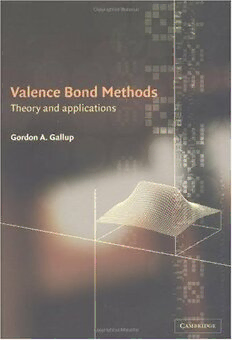Table Of ContentValence Bond Methods
Theory and applications
Gordon A. Gallup
VALENCE BOND METHODS
Theoryandapplications
Valencebondtheoryisoneoftwocommonlyusedmethodsinmolecularquantum
mechanics, the other is molecular orbital theory. This book focuses on the first of
thesemethods,abinitiovalencebondtheory.
The book is split into two parts. Part I gives simple examples of two-electron
calculationsandthenecessarytheorytoextendthesetolargersystems.PartIIgives
aseriesofcasestudiesofrelatedmoleculesetsdesignedtoshowthenatureofthe
valencebonddescriptionofmolecularstructure.Italsohighlightsthestabilityofthis
description to varying basis sets. There are references to the CRUNCH computer
program for molecular structure calculations, which is currently available in the
publicdomain.Throughoutthebooktherearesuggestionsforfurtherstudyusing
CRUNCHtosupplementdiscussionsandquestionsraisedinthetext.
The book will be of primary interest to researchers and students working on
molecularelectronictheoryandcomputationinchemistryandchemicalphysics.
GORDON A. GALLUP wasborn(9March1927)andraisedinStLouis,Missouri
andattendedthepublicschoolsthere.AfterHighSchoolandashortstintintheUS
Navy,heattendedWashingtonUniversity(StLouis)andgraduatedwithanABin
1950.HereceivedthePhDdegreefromtheUniversityofKansasin1953andspent
twoyearsatPurdueUniversitycarryingoutpost-doctoralresearch.In1955hewas
appointedtothefacultyofchemistryattheUniversityofNebraskaandrosethrough
theranks,becomingfullprofessorin1964.HespentayearattheQuantumTheory
Project at the University of Florida, and a year in England at the University of
BristolonanSERCfellowship.In1993heretiredfromteachingandsincethenhas
spenttimeasaresearchprofessorwiththeDepartmentofPhysicsandAstronomy
attheUniversityofNebraska.Hisresearchinterestsovertheyearsincludeinfrared
spectroscopy and molecule vibrations, theory of molecular electronic structure,
valencebondtheory,electronscatteringfromatomsandmolecules,anddissociative
electronattachment.DuringhiscareerhehasheldgrantsfromtheNationalScience
Foundation, the Department of Energy, and others. He has had over 100 articles
publishedin10–15differentchemistryandphysicsjournals,aswellasarticlesin
editedcompendiaandreviewbooks.
This Page Intentionally Left Blank
VALENCE BOND METHODS
Theory and applications
GORDON A. GALLUP
UniversityofNebraska
PUBLISHED BY CAMBRIDGE UNIVERSITY PRESS (VIRTUAL PUBLISHING)
FOR AND ON BEHALF OF THE PRESS SYNDICATE OF THE UNIVERSITY OF
CAMBRIDGE
The Pitt Building, Trumpington Street, Cambridge CB2 IRP
40 West 20th Street, New York, NY 10011-4211, USA
477 Williamstown Road, Port Melbourne, VIC 3207, Australia
http://www.cambridge.org
© Gordon A. Gallup 2002
This edition © Gordon A. Gallup 2003
First published in printed format 2002
A catalogue record for the original printed book is available
from the British Library and from the Library of Congress
Original ISBN 0 521 80392 6 hardback
ISBN 0 511 02037 6 virtual (netLibrary Edition)
TomywifeGrace,forallherencouragement,andtothememoryofour
son,Michael,1956–1995.
This Page Intentionally Left Blank
Contents
Preface pagexiii
Listofabbreviations xv
I Theoryandtwo-electronsystems
1 Introduction 3
1.1 History 3
1.2 Mathematicalbackground 4
1.2.1 Schro¨dinger’sequation 5
1.3 Thevariationtheorem 9
1.3.1 Generalvariationfunctions 9
1.3.2 Linearvariationfunctions 9
1.3.3 A2×2generalizedeigenvalueproblem 14
1.4 Weightsofnonorthogonalfunctions 16
1.4.1 Weightswithoutorthogonalization 18
1.4.2 Weightsrequiringorthogonalization 19
2 H andlocalizedorbitals 23
2
2.1 Theseparationofspinandspacevariables 23
2.1.1 Thespinfunctions 23
2.1.2 Thespatialfunctions 24
2.2 TheAOapproximation 24
2.3 AccuracyoftheHeitler–Londonfunction 27
2.4 ExtensionstothesimpleHeitler–Londontreatment 27
2.5 WhyistheH moleculestable? 31
2
2.5.1 Electrostaticinteractions 32
2.5.2 Kineticenergyeffects 36
2.6 Electroncorrelation 38
2.7 GaussianAObases 38
2.8 AfullMCVBcalculation 38
vii
viii Contents
2.8.1 TwodifferentAObases 40
2.8.2 Effectofeliminatingvariousstructures 42
2.8.3 AccuracyoffullMCVBcalculationwith10AOs 44
2.8.4 AccuracyoffullMCVBcalculationwith28AOs 44
2.8.5 EGSOweightsfor10and28AOorthogonalizedbases 45
3 H anddelocalizedorbitals 47
2
3.1 OrthogonalizedAOs 47
3.2 Optimaldelocalizedorbitals 49
3.2.1 ThemethodofCoulsonandFisher[15] 49
3.2.2 Complementaryorbitals 49
3.2.3 Unsymmetricorbitals 51
4 Threeelectronsindoubletstates 53
4.1 Spineigenfunctions 53
4.2 Requirementsofspatialfunctions 55
4.3 Orbitalapproximation 58
5 Advancedmethodsforlargermolecules 63
5.1 Permutations 64
5.2 Groupalgebras 66
5.3 Somegeneralresultsforfinitegroups 68
5.3.1 Irreduciblematrixrepresentations 68
5.3.2 Basesforgroupalgebras 69
5.4 Algebrasofsymmetricgroups 70
5.4.1 Theunitarityofpermutations 70
5.4.2 Partitions 70
5.4.3 YoungtableauxandN andP operators 71
5.4.4 Standardtableaux 72
5.4.5 ThelinearindependenceofN P andP N 75
i i i i
5.4.6 VonNeumann’stheorem 76
5.4.7 TwoHermitianidempotentsofthegroupalgebra 76
5.4.8 Amatrixbasisforgroupalgebrasofsymmetricgroups 77
5.4.9 Sandwichrepresentations 79
5.4.10 Groupalgebraicrepresentationoftheantisymmetrizer 80
5.5 Antisymmetriceigenfunctionsofthespin 81
5.5.1 Twosimpleeigenfunctionsofthespin 81
5.5.2 The(cid:2) function 84
5.5.3 Theindependentfunctionsfromanorbitalproduct 85
5.5.4 TwosimplesortsofVBfunctions 87
5.5.5 TransformationsbetweenstandardtableauxandHLSP
functions 88
5.5.6 Representingθ NPN(cid:2)asafunctionaldeterminant 91
Contents ix
6 Spatialsymmetry 97
6.1 TheAObasis 98
6.2 Basesforspatialgroupalgebras 98
6.3 Constellationsandconfigurations 99
6.3.1 Example1.H O 100
2
6.3.2 Example2.NH 102
3
6.3.3 Example3.Theπ systemofbenzene 105
7 VarietiesofVBtreatments 107
7.1 Localorbitals 107
7.2 Nonlocalorbitals 108
8 Thephysicsofionicstructures 111
8.1 Asillytwo-electronexample 111
8.2 IonicstructuresandtheelectricmomentofLiH 113
8.3 CovalentandioniccurvecrossingsinLiF 115
II Examplesandinterpretations
9 Selectionofstructuresandarrangementofbases 121
9.1 TheAObases 121
9.2 Structureselection 123
9.2.1 N andanSTO3Gbasis 123
2
9.2.2 N anda6-31Gbasis 123
2
∗
9.2.3 N anda6-31G basis 124
2
9.3 Planararomaticandπ systems 124
10 Foursimplethree-electronsystems 125
10.1 Theallylradical 125
10.1.1 MCVBtreatment 126
10.1.2 ExampleoftransformationtoHLSPfunctions 129
10.1.3 SCVBtreatmentwithcorrespondingorbitals 132
+
10.2 TheHe ion 134
2
10.2.1 MCVBcalculation 134
10.2.2 SCVBwithcorrespondingorbitals 135
10.3 ThevalenceorbitalsoftheBeHmolecule 136
10.3.1 FullMCVBtreatment 137
10.3.2 AnSCVBtreatment 139
10.4 TheLiatom 141
10.4.1 SCVBtreatment 142
10.4.2 MCVBtreatment 144
11 Secondrowhomonucleardiatomics 145
11.1 Atomicproperties 145
11.2 Arrangementofbasesandquantitativeresults 146

